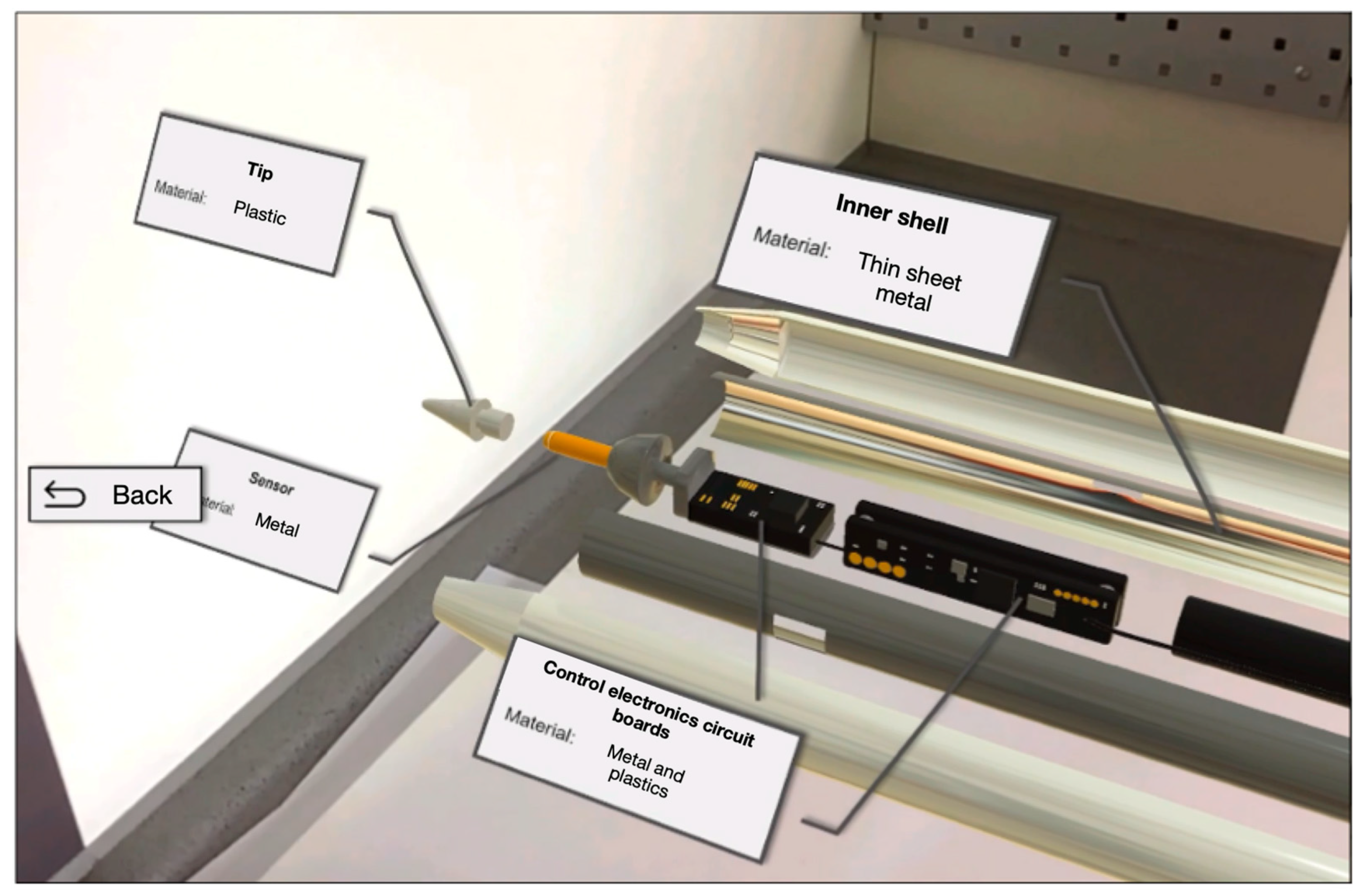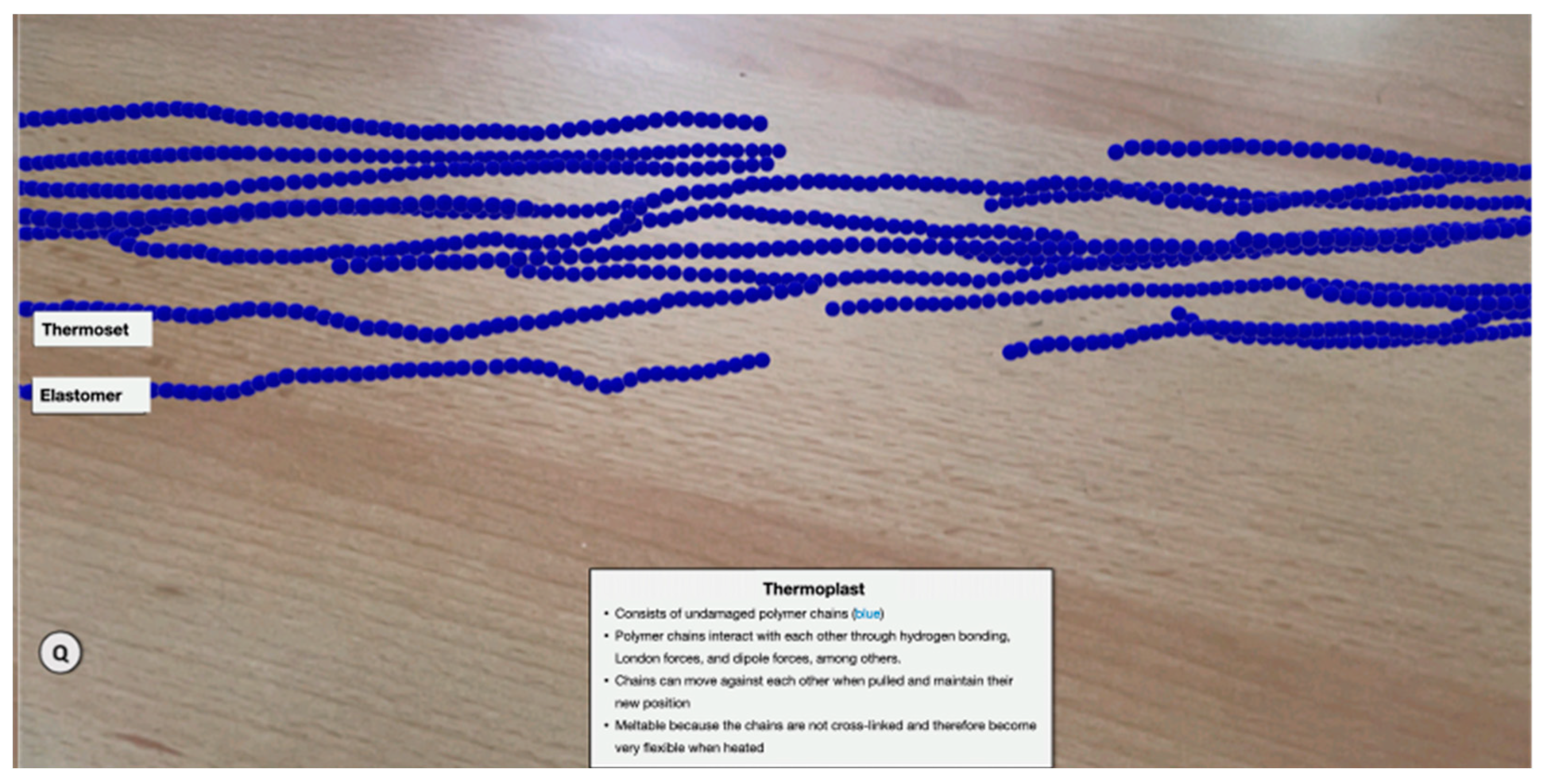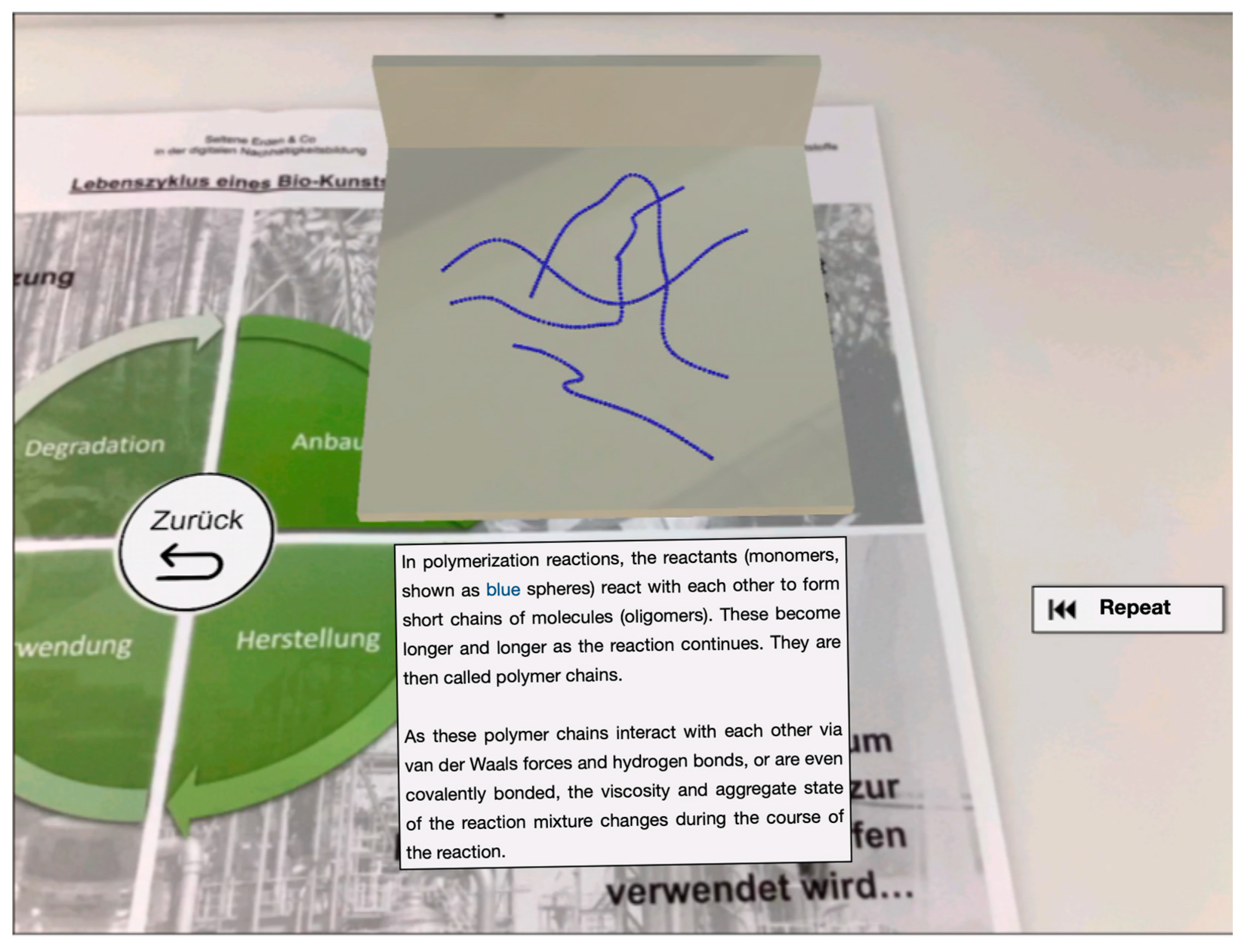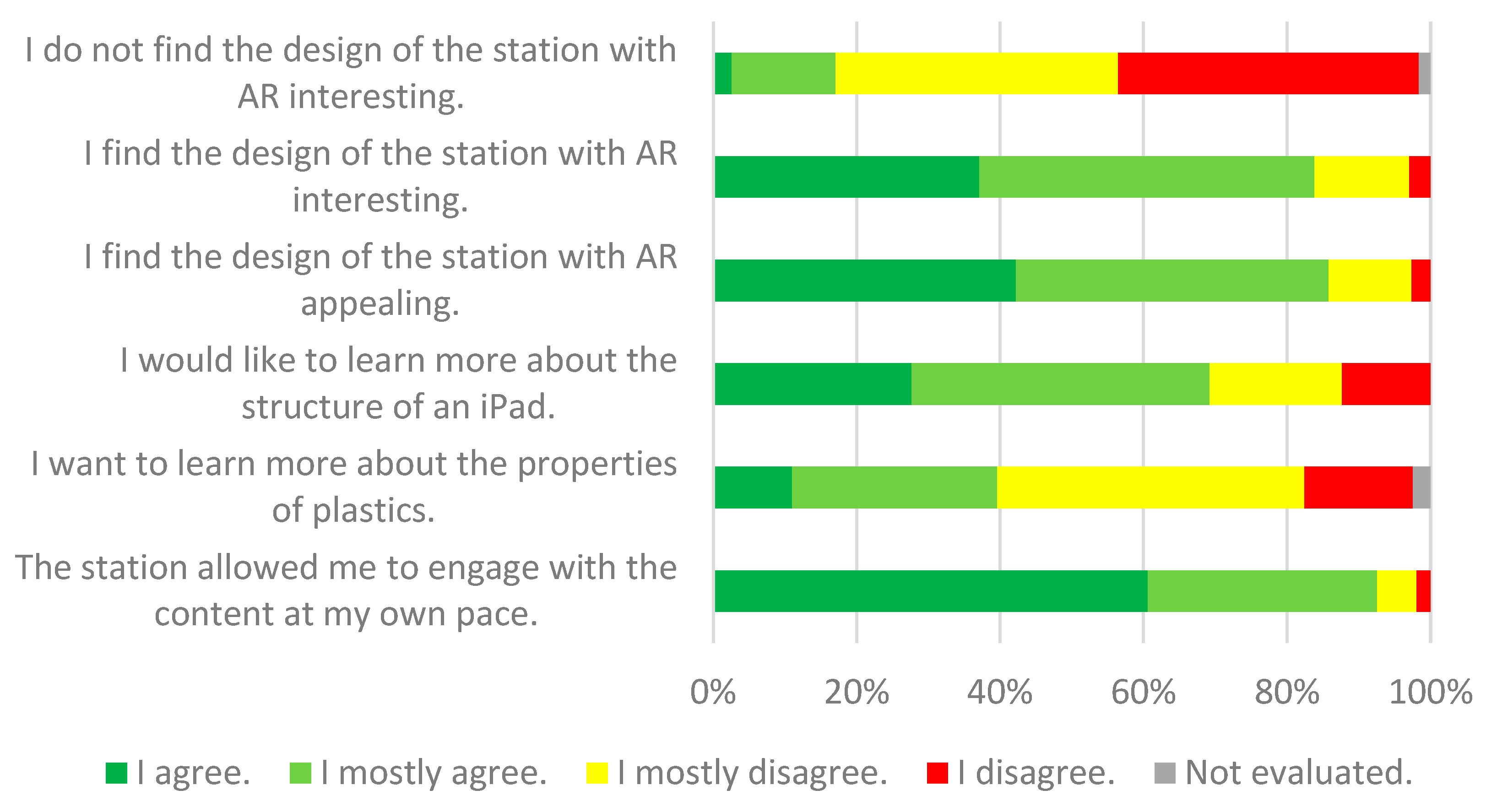Interactive Learning with iPads and Augmented Reality: A Sustainability-Oriented Approach to Teaching Plastics Chemistry
Abstract
1. Introduction
2. Research Questions
- RQ1: What effect does the simultaneous use of iPads as a learning tool and as a learning object have on pupils’ understanding of the use of plastic in these devices?
- RQ2: What attitude do students have toward learning with AR in chemistry lessons after implementing the AR learning scenario?
- RQ3: How does the simultaneous use of iPads as a learning tool and as a learning object affect the students’ situational interest regarding the use of plastic in these devices?
3. Sample and Method
3.1. Context and Participants
3.2. Data Collection
3.3. Questionnaire
4. Learning Scenario
4.1. Design and Used Programs
4.2. Introduction
4.3. Sub-Topic 1: Construction of an iPad with a Focus on the Plastics Used in the Components
4.4. Sub-Topic 2: Properties of Plastics
4.5. Sub-Topic 3: Production and Processing of Plastics
4.6. Sub-Topic 4: Recycling of Plastics
4.7. Sub-Topic 5: Substitution
4.8. Debriefing
5. Results and Discussion
5.1. RQ1
5.2. RQ2
5.3. RQ3
6. Limitations
7. Conclusions
Supplementary Materials
Author Contributions
Funding
Institutional Review Board Statement
Informed Consent Statement
Data Availability Statement
Conflicts of Interest
References
- The Common Sense Census: Media Use by Tweens and Teens. 2021. Available online: https://www.commonsensemedia.org/research/the-common-sense-census-media-use-by-tweens-and-teens-2021 (accessed on 19 October 2023).
- Kuhn, J.; Vogt, P. (Eds.) Smartphones as Mobile Minilabs in Physics: Edited Volume Featuring More Than 70 Examples from 10 Years the Physics Teacher-Column iPhysicsLabs; Springer: Cham, Switzerland, 2022. [Google Scholar] [CrossRef]
- Pence, H.E.; Williams, A.J.; Belford, R.E. New Tools and Challenges for Chemical Education: Mobile Learning, Augmented Reality, and Distributed Cognition in the Dawn of the Social and Semantic Web. In Chemistry Education; García-Martínez, J., Serrano-Torregrosa, E., Eds.; Wiley: Weinheim, Germany, 2015; pp. 693–734. [Google Scholar] [CrossRef]
- Milgram, P.; Takemura, H.; Utsumi, A.; Kishino, F. Augmented reality: A class of displays on the reality-virtuality continuum. In Telemanipulator and Telepresence Technologies, Proceedings of Photonics for Industrial Applications, Boston, MA, USA, 31 October–4 November 1994; Das, H., Ed.; SPIE: Bellingham, WA, USA, 1995; pp. 282–292. [Google Scholar] [CrossRef]
- Azuma, R.T. A Survey of Augmented Reality. Presence Teleoperators Virtual Environ. 1997, 6, 355–385. [Google Scholar] [CrossRef]
- Clarke, B.; Svanaes, S. An Updated Literature Review on the Use of Tablets in Education. In Tablets for Schools; Family Kids & Youth: London, UK, 2014; pp. 1–18. [Google Scholar]
- Wu, H.-K.; Lee, S.W.-Y.; Chang, H.-Y.; Liang, J.-C. Current status, opportunities and challenges of augmented reality in education. Comp. Educ. 2013, 62, 41–49. [Google Scholar] [CrossRef]
- Barth, C.; Siol, A.; Eilks, I.; Huwer, J. Combining reflections on education for sustainability and digitalization—Learning with and about the sustainable use of tablets along an augmented reality learning environment. Chemkon 2021, 28, 235–240. [Google Scholar] [CrossRef]
- Radu, I.; Schneider, B. What Can We Learn from Augmented Reality (AR)? Benefits and Drawbacks of AR for Inquiry-based Learning of Physics. In Proceedings of the CHI ’19, 2019 CHI Conference on Human Factors in Computing Systems, Glasgow, UK, 4–9 May 2019. [Google Scholar] [CrossRef]
- Hillmayr, D.; Ziernwald, L.; Reinhold, F.; Hofer, V.; Reiss, K.M. The potential of digital tools to enhance mathematics and science learning in secondary schools: A context-specific meta-analysis. Comp. Educ. 2020, 153, 103897. [Google Scholar] [CrossRef]
- Salmi, H.; Kaasinen, A.; Kallunki, V. Towards an Open Learning Environment via Augmented Reality (AR): Visualising the Invisible in Science Centres and Schools for Teacher Education. Procedia-Soc. Behav. Sci. 2012, 45, 284–295. [Google Scholar] [CrossRef]
- Wang, M.; Callaghan, V.; Bernhardt, J.; White, K.; Peña-Rios, A. Augmented reality in education and training: Pedagogical approaches and illustrative case studies. J. Ambient. Intell. Hum. Comput. 2018, 9, 1391–1402. [Google Scholar] [CrossRef]
- Quqandi, E.; Joy, M.; Rushton, M.; Drumm, I. Mobile Augmented Reality in Nursing Educational Environments. In Proceedings of the 10th Computer Science and Electronic Engineering (CEEC), Essex, UK, 19–21 September 2018; pp. 266–269. [Google Scholar] [CrossRef]
- Sun, J.C.-Y.; Ye, S.-L.; Yu, S.-J.; Chiu, T.K.F. Effects of Wearable Hybrid AR/VR Learning Material on High School Students’ Situational Interest, Engagement, and Learning Performance: The Case of a Physics Laboratory Learning Environment. J. Sci. Educ. Technol. 2023, 32, 1–12. [Google Scholar] [CrossRef]
- Woźniak, M.; Lewczuk, A.; Adamkiewicz, K.; Józiewicz, J.; Jaworski, T.; Rowińska, Z. ARchemist: Towards in-situ experimental guidance using augmented reality technology. In Proceedings of the 18th International Conference on Advances in Mobile Computing & Multimedia, Chiang Mai, Thailand, 30 November 2020; pp. 58–63. [Google Scholar] [CrossRef]
- Yu, S.; Liu, Q.; Ma, J.; Le, H.; Ba, S. Applying Augmented reality to enhance physics laboratory experience: Does learning anxiety matter? Interact. Learn. Environ. 2023, 31, 6952–6967. [Google Scholar] [CrossRef]
- Dhir, A.; Gahwaji, N.; Nyman, G. The Role of the iPad in the Hands of the Learner. J. Universal Comp. Sci. 2013, 19, 706–727. [Google Scholar]
- Nguyen, L.; Barton, S.M.; Nguyen, L.T. iPads in higher education—Hype and hope. British. J. Educ. Technol. 2015, 46, 190–203. [Google Scholar] [CrossRef]
- Stuckey, M.; Hofstein, A.; Mamlok-Naaman, R.; Eilks, I. The meaning of ‘relevance’ in science education and its implications for the science curriculum. Stud. Sci. Educ. 2013, 49, 1–34. [Google Scholar] [CrossRef]
- Marks, R.; Eilks, I. Promoting Scientific Literacy Using a Sociocritical and Problem-Oriented Approach to Chemistry Teaching: Concept, Examples, Experiences. Int. J. Environ. Sci. Educ. 2009, 4, 131–145. [Google Scholar]
- Mahaffy, P.G.; Krief, A.; Hopf, H.; Mehta, G.; Matlin, S.A. Reorienting chemistry education through systems thinking. Nat. Rev. Chem. 2018, 2, 126. [Google Scholar] [CrossRef]
- Huwer, J.; Barth, C.; Siol, A.; Eilks, I. Learning with Digital Media about the Chemistry behind the Recycling of Digital Hardware. In Digital Learning and Teaching in Chemistry; Dori, Y.J., Ngai, C., Szteinberg, G., Eds.; RSC: Cambridge, UK, 2023; pp. 81–92. [Google Scholar]
- Fong, C.J.; Patall, E.A.; Vasquez, A.C.; Stautberg, S. A Meta-Analysis of Negative Feedback on Intrinsic Motivation. Educ. Psychol. Rev. 2019, 31, 121–162. [Google Scholar] [CrossRef]
- Bortz, J.; Döring, N. Research Methods and Evaluation: For Human and Social Scientists [Forschungsmethoden und Evaluation: Für Human- und Sozialwissenschaftler], 4th ed.; Springer: Heidelberg, Germany, 2006. [Google Scholar]
- Rheinberg, F.; Vollmeyer, R.; Burns, B.D. QCM: A questionnaire to assess current motivation in learning situations. Diagnostica 2001, 47, 57–66. [Google Scholar] [CrossRef]
- Johnstone, A.H. Teaching of Chemistry—Logical or Psychological? Chem. Educ. Res. Pract. 2000, 1, 9–15. [Google Scholar] [CrossRef]
- Böhringer, J.; Bühler, P.; Schlaich, P. (Eds.) Compendium of Media Design [Kompendium der Mediengestaltung: Konzeption und Gestaltung für Digital- und Printmedien]; Springer: Berlin, Germany, 2011. [Google Scholar]
- Low, R.; Sweller, J. The Modality Principle in Multimedia Learning. In The Cambridge Handbook of Multimedia Learning, 2nd ed.; Mayer, R.E., Ed.; Cambridge University Press: Cambridge, UK, 2014; pp. 227–246. [Google Scholar] [CrossRef]
- van Gog, T. The Signaling (or Cueing) Principle in Multimedia Learning. In The Cambridge Handbook of Multimedia Learning, 2nd ed.; Mayer, R.E., Ed.; Cambridge University Press: Cambridge, UK, 2014; pp. 263–278. [Google Scholar] [CrossRef]
- Mayer, V.; Fiorella, L. Principles for Reducing Extraneous Processing in Multimedia Learning: Coherence, Signaling, Redundancy, Spatial Contiguity, and Temporal Contiguity Principles. In The Cambridge Handbook of Multimedia Learning, 2nd ed.; Mayer, R.E., Ed.; Cambridge University Press: Cambridge, UK, 2014; pp. 279–315. [Google Scholar] [CrossRef]
- Scheiter, K. The Learner Control Principle in Multimedia Learning. In The Cambridge Handbook of Multimedia Learning, 2nd ed.; Mayer, R.E., Ed.; Cambridge University Press: Cambridge, UK, 2014; pp. 487–512. [Google Scholar] [CrossRef]
- Ayres, P.; Sweller, J. The Split-Attention Principle in Multimedia Learning. In The Cambridge Handbook of Multimedia Learning, 2nd ed.; Mayer, R.E., Ed.; Cambridge University Press: Cambridge, UK, 2014; pp. 206–226. [Google Scholar] [CrossRef]
- Apple Inc. (Ed.) Product Environmental Report iPad (9th Generation). 2021. Available online: https://www.apple.com/environment/pdf/products/ipad/iPad_PER_Dec2022.pdf (accessed on 8 February 2024).
- Becker, N.; Mundzeck, L.; Siebert-Raths, A. Biopolymers Facts and Statistics 2021—Production Capacities, Processing Routes, Feedstock, Land and Water Use; IfBB: Hannover, Germany, 2021. [Google Scholar]
- Farah, S.; Anderson, D.G.; Langer, R. Physical and mechanical properties of PLA and their functions in widespread applications—A comprehensive review. Adv. Drug Deliv. Rev. 2016, 107, 367–392. [Google Scholar] [CrossRef] [PubMed]
- Hossain, S.; Rahman, M.A.; Chowdhury, M.A.; Mohonta, S.K. Plastic pollution in Bangladesh: A review on current status emphasizing the impacts on environment and public health. Environ. Eng. Res. 2021, 26, 200535. [Google Scholar] [CrossRef]
- Hamad, K.; Kaseem, M.; Yang, H.W.; Deri, F.; Ko, Y.-G. Properties and medical applications of polylactic acid: A review. eXPRESS Polym. Lett. 2015, 9, 435–455. [Google Scholar] [CrossRef]
- Benavides, P.T.; Lee, U.; Zarè-Mehrjerdi, O. Life cycle greenhouse gas emissions and energy use of polylactic acid, bio-derived polyethylene, and fossil-derived polyethylene. J. Clean. Prod. 2020, 277, 124010. [Google Scholar] [CrossRef]
- Waste Framework Directive. Available online: https://environment.ec.europa.eu/topics/waste-and-recycling/waste-framework-directive_en (accessed on 7 February 2024).
- Deci, E.; Ryan, R.M. Curiosity and Self-Directed Learning: The Role of Motivation in Education. In Current Topics in Early Childhood Education, 4th ed.; Katz, L.G., Ed.; Ablex Publishing Corporation: Norwood, MA, USA, 1982; pp. 71–86. [Google Scholar]
- Chandler, P.; Sweller, J. Cognitive Load Theory and the Format of Instruction. Cogn. Instr. 1991, 8, 293–332. [Google Scholar] [CrossRef]
- Bikowski, D.; Elliott Casal, J. Interactive digital textbooks and engagement: A learning strategies framework. Lang. Learn. Technol. 2018, 22, 119–136. [Google Scholar]
- Roussou, M. Learning by doing and learning through play: An exploration of interactivity in virtual environments for children. ACM Comput. Entertain. 2004, 2, 1–23. [Google Scholar] [CrossRef]
- Gan, B.; Menkhoff, T.; Smith, R. Enhancing students’ learning process through interactive digital media: New opportunities for collaborative learning. Comput. Hum. Behav. 2015, 51, 652–663. [Google Scholar] [CrossRef]
- Nentwig, P.M.; Demuth, R.; Parchmann, I.; Ralle, B.; Gräsel, C. Chemie im Kontext: Situating Learning in Relevant Contexts while Systematically Developing Basic Chemical Concepts. J. Chem. Educ. 2007, 84, 1439. [Google Scholar] [CrossRef]
- Sevian, H.; Dori, Y.J.; Parchmann, I. How does STEM context-based learning work: What we know and what we still do not know. Int. J. Sci. Educ. 2018, 40, 1095–1107. [Google Scholar] [CrossRef]
- Habig, S.; Blankenburg, J.; van Vorst, H.; Fechner, S.; Parchmann, I.; Sumfleth, E. Context characteristics and their effects on students’ situational interest in chemistry. Int. J. Sci. Educ. 2018, 40, 1154–1175. [Google Scholar] [CrossRef]
- Minnaert, A.; Boekaerts, M.; De Brabander, C. Autonomy, Competence, and Social Relatedness in Task Interest within Project-Based Education. Psychol. Rep. 2007, 101, 574–586. [Google Scholar] [CrossRef]
- Yu, S.J.; Sun, J.Y.; Chen, O.C. Effect of AR-based online wearable guides on university students’ situational interest and learning performance. Univ. Access Inf. Soc. 2019, 18, 287–299. [Google Scholar] [CrossRef]









Disclaimer/Publisher’s Note: The statements, opinions and data contained in all publications are solely those of the individual author(s) and contributor(s) and not of MDPI and/or the editor(s). MDPI and/or the editor(s) disclaim responsibility for any injury to people or property resulting from any ideas, methods, instructions or products referred to in the content. |
© 2024 by the authors. Licensee MDPI, Basel, Switzerland. This article is an open access article distributed under the terms and conditions of the Creative Commons Attribution (CC BY) license (https://creativecommons.org/licenses/by/4.0/).
Share and Cite
Syskowski, S.; Lathwesen, C.; Maurer, N.; Siol, A.; Eilks, I.; Huwer, J. Interactive Learning with iPads and Augmented Reality: A Sustainability-Oriented Approach to Teaching Plastics Chemistry. Sustainability 2024, 16, 3342. https://doi.org/10.3390/su16083342
Syskowski S, Lathwesen C, Maurer N, Siol A, Eilks I, Huwer J. Interactive Learning with iPads and Augmented Reality: A Sustainability-Oriented Approach to Teaching Plastics Chemistry. Sustainability. 2024; 16(8):3342. https://doi.org/10.3390/su16083342
Chicago/Turabian StyleSyskowski, Sabrina, Chantal Lathwesen, Nikolai Maurer, Antje Siol, Ingo Eilks, and Johannes Huwer. 2024. "Interactive Learning with iPads and Augmented Reality: A Sustainability-Oriented Approach to Teaching Plastics Chemistry" Sustainability 16, no. 8: 3342. https://doi.org/10.3390/su16083342
APA StyleSyskowski, S., Lathwesen, C., Maurer, N., Siol, A., Eilks, I., & Huwer, J. (2024). Interactive Learning with iPads and Augmented Reality: A Sustainability-Oriented Approach to Teaching Plastics Chemistry. Sustainability, 16(8), 3342. https://doi.org/10.3390/su16083342








